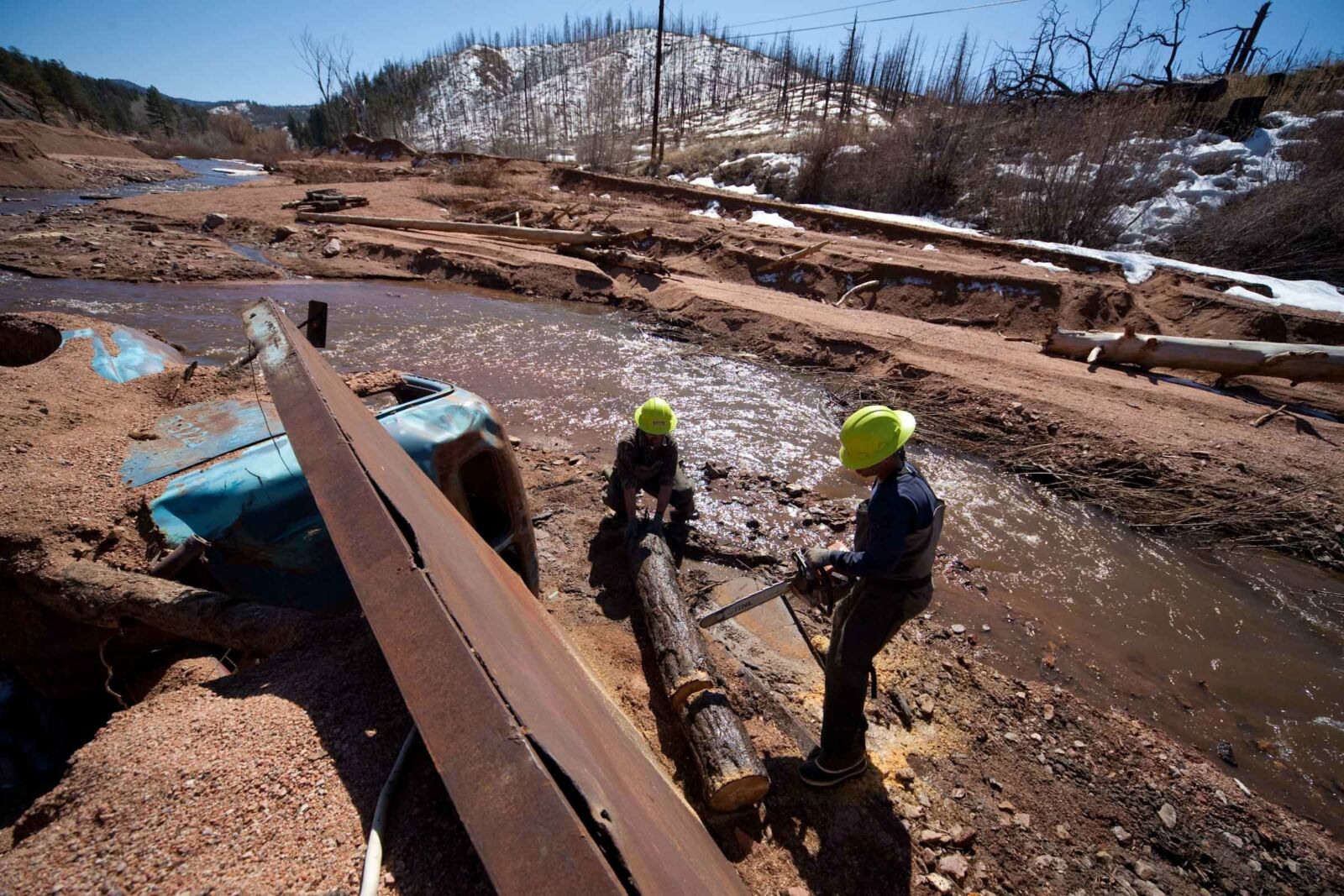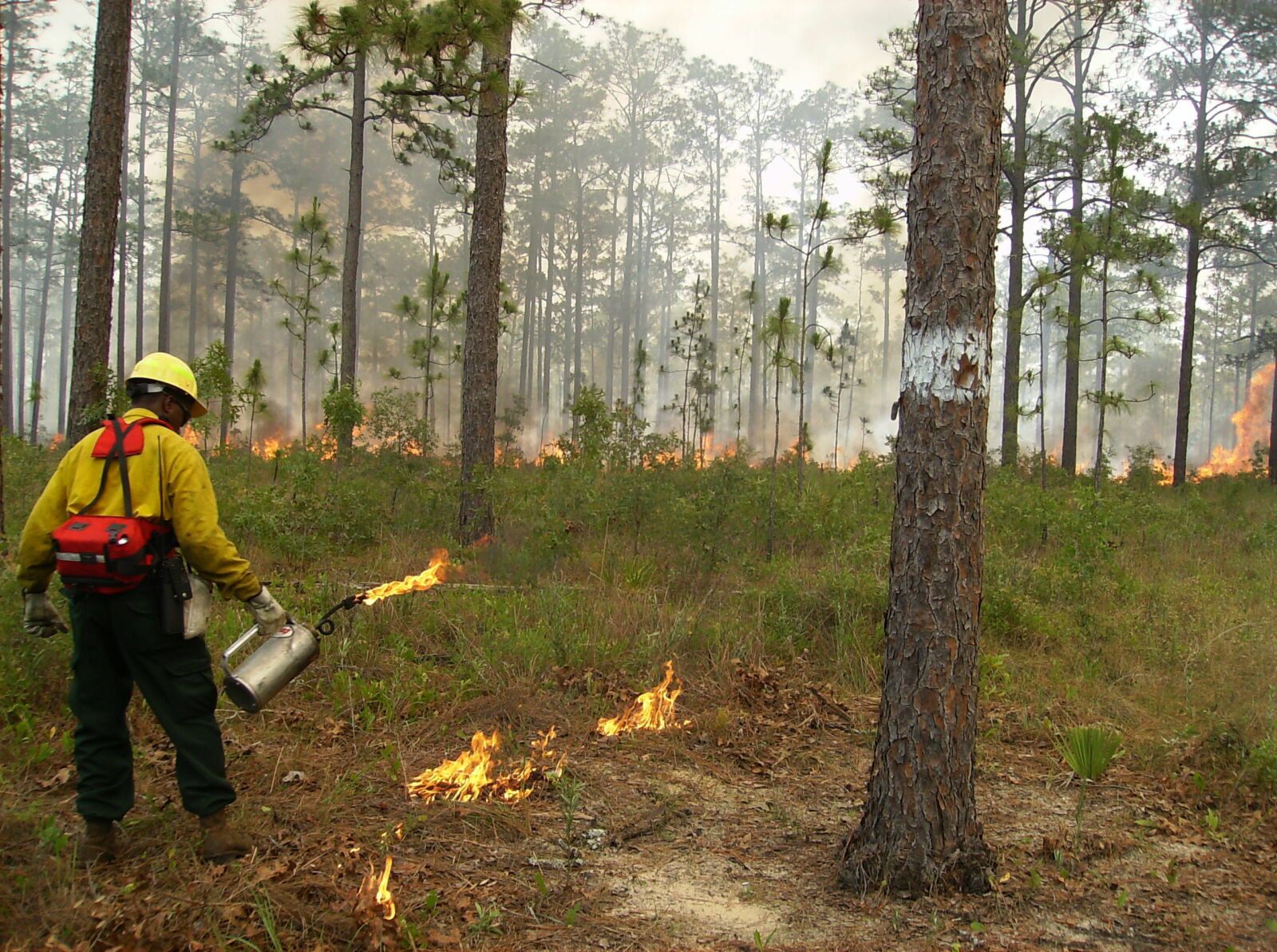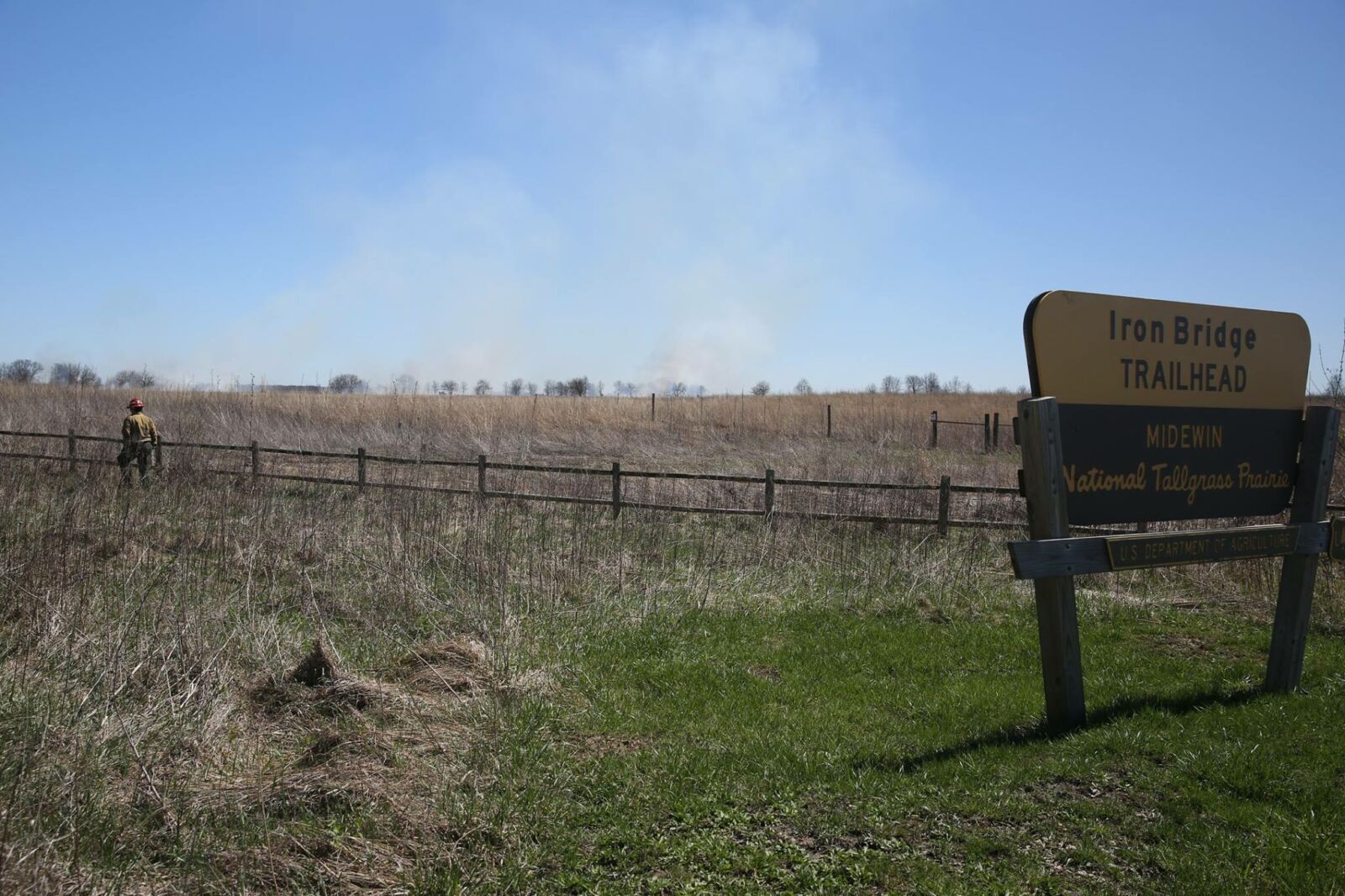Ocala National Forest’s longleaf pine savannahs. Midewin National Tallgrass Prairie’s swaying wildflowers. Pike National Forest’s sky-scraping Rocky Mountain peaks. These fascinating landscapes are as different from each other as French is from English or German from Korean. Or at least they seem that way.
If you’re a fan of the NFF, you’re probably familiar with these places. They are all sites in our long-running Treasured Landscapes, Unforgettable Experiences conservation program. And yes, they do represent very different ecosystems and face diverse threats. But aside from the NFF’s commitment to each and the fact that they are managed by the U.S. Forest Service as National Forests or Grasslands, they have something else in common: they’ve all been affected by fire.
Beginning with our very first Treasured Landscapes site, the Pike National Forest in Colorado, fire has played an integral role in both how we approach our conservation goals at these sites and how the Forest Service manages them.
Pike National Forest, Colorado
Our work on the Pike was necessitated by fire. In 2002, the Hayman Fire raged across the Pike-San Isabel National Forests just 95 miles southwest of Denver. The arson-caused inferno became the largest wildfire in Colorado’s history and consumed 138,114 acres and 133 homes and cost nearly $40 million to fight.
In addition to being the backyard for millions of front-range residents, the Pike-San Isabel is also an important watershed for Denver and other frontrange communities. Massive fires, like the Hayman, wreak havoc on watersheds. Without trees and other vegetation to hold snowpack and to help slow and absorb rain water, the charred ground sloughs into creeks and rivers, polluting water reservoirs and affecting fisheries.
Early efforts following the fire started the healing process. New saplings and grass seeding helped slow the worst of the erosion and sedimentation that affected the watershed. But critical tributaries in the Upper South Platte River watershed were severely impacted by monsoon rains that followed the fire and required significant restoration years after the Hayman was snuffed out.

In 2009, the NFF organized a coalition of partners to tackle this work and pioneer post-fire restoration techniques. For five years, the NFF, the Forest Service and our partners worked across 17 different sites in the Trail Creek watershed (the critical Upper South Platte tributary) as volunteers, heavy equipment operators and restoration crews restored the extensive damage. Renowned hydrologist David Rosgen helped design and implement innovative restoration techniques that have since been used in other fire-affected areas in the West.
Just two years after completing our Trail Creek stream restoration and reconstruction projects, brook trout and brown trout reappeared in the restored waterway. In three years, beavers returned. While no doubt delighting anglers, the presence of trout and beaver underscores how successful this project proved to be. In 2012, ten years after the Hayman Fire, the NFF partnered with several groups to plan and host the Hayman Fire Science Symposium, where we shared what we learned about post-fire restoration with researchers, scientists, managers and others. In 2013 and 2014, many of the lessons and techniques we learned through our Hayman restoration work were put into practice after Colorado’s Waldo Canyon and Black Forest Fires.
Ocala National Forest, Florida
Almost two thousand miles from the Mile High City, Florida’s Ocala National Forest offers a different glimpse of how fire affects forest ecosystems. Longleaf pine forests once dominated the Southeast, stretching across 92 million acres from the coastal lowlands of North Carolina to the plains of eastern Texas. Today, less than two percent of those stands remain. One stronghold is the Ocala National Forest where the savannah-like stands of longleaf provide rich habitat for a wide variety of species.
Longleaf forests feature some of the greatest diversity of plants and animals in the Southeast, providing habitat for nearly 60 percent of the region’s reptiles and amphibians and hosting an incredible 900 endemic plant species. In addition, 29 federally listed threatened or endangered species, including the Red-cockaded woodpecker, call longleaf pine forests home.
The Southeast is much wetter than Colorado, but it has never been immune to fire. In fact, longleaf pine trees are so adapted to fire that they’re considered “fire-dependent,” meaning that without fire, trees can’t reproduce, wildlife actually lose habitat and the ecosystem begins to collapse. Wire grass, an important ground cover in longleaf forests, has extensive underground root systems that survive fast-moving fires and rapidly re-sprout after a blaze, providing habitat and food for myriad species.

Longleaf pines have thick bark that protects them from fire. Their seedlings grow quickly in the bare ground that’s present after fire moves through the forest, reaching heights that keep them out of the next fire’s path in just a few years. Red-cockaded woodpeckers nest and rear their young in oldgrowth longleaf trees, which for centuries were plentiful in the Ocala.
Because the historically frequent fires killed off competing oak trees, the woodpeckers had plenty of habitat. With fire suppression, the oak trees started out-competing the longleafs and changed the forest composition. Longleaf pines no longer dominated the landscape and woodpeckers struggled to reproduce. Simply put, without fire, longleaf forests and the diversity of life they support, can’t survive.
Today, the Ocala National Forest uses a mix of management techniques, including prescribed fire, to benefit the landscape. Prescribed fires are intentionally set by forest managers and mimic historic fire regimes. In partnership with the NFF and local Boy Scout troops, the Forest is also controlling oak encroachment without the use of fire, but fire remains a critical management tool for this fire-dependent ecosystem.
Midewin National Tallgrass Prairie, Illinois
An hour south and a world away from Chicago’s famous skyline, visitors can find a unique and historic treasure at Midewin National Tallgrass Prairie. This captivating landscape is home to deer, foxes, more than 100 bird species and (thanks to the NFF and our partners) a herd of wild bison. But Midewin hasn’t always been the natural wonder it is today.
Hundreds of years ago, tallgrass prairies covered millions of acres of the Midwest. As settlers pushed farther west, the prairie fell to the plow, and today only one-tenth of one percent of Illinois’ original 21 million acres of prairie remain. While it may be tempting to believe that Midewin has been long-preserved as a key representative of tallgrass prairies, that’s not the whole story.
In the 1940s, the U.S. government bought out the last of the small family farms dotting what is now Midewin and commenced building a massive arsenal to provide bombs and explosives for the war effort. For decades, the Joliet Arsenal’s 10,000 workers manufactured TNT, bombs and other munitions for WWII, Korea and Vietnam.
The area also supported corn and soybean agriculture and cattle ranching. In the 1990s, the land was transferred from the Department of Defense to the U.S. Forest Service, which named it Midewin after a Potawatomi word for “healing.” Through dedicated restoration efforts, Midewin’s future as a tallgrass prairie is now being realized.
Tallgrass prairies may seem like simple grasslands at first glance, but a deeper view shows that they are complex systems with wetlands, ponds and varied micro habitats. And like the dry forests of the Rockies and the longleaf pine savannahs in Florida, tallgrass prairie is a fire dependent ecosystem. Tallgrass prairie plants not only grow tall above ground, their massive roots systems, often “taller” than the plants themselves, drive deep into the ground.
Lightning, a frequent presence in the Plains, ignited these vast grasslands which burned every five years or so. Native Americans also used fire to drive game and restore prairie productivity. These frequent fires helped control trees, which naturally encroach on prairie landscapes, and returned nutrients to the soil. The prairie plants’ deep roots easily survived these fires and simply sprouted again once rains doused the flames. As prairies turned into farms, fire no longer played its critical role in the small remnant prairies that remained.

Now, Forest Service staff at Midewin regularly use fire to maintain the prairie’s health and control invasive plants, which are not as well adapted to fire as the native prairie grasses and wildflowers. In fact, Midewin has its own professional fire crew: the Midewin Interagency Hotshots. When conditions allow (typically in the spring and fall) these professionals don special fire suits and spend their days doing what lightning used to do: burning the prairie.
Even though fire is critical to Midewin’s health, burning thousands of acres of prairie surrounded by bustling farms, quaint towns and important transportation infrastructure like highways and railroads all just 60 miles from Chicago is a delicate of burning schedules and even uses a very modern communication technique – Facebook – to inform the public about this oldest of prairie management tools.
A March 20th, 2017 Facebook post from Midewin’s Restoration Team Leader, Drew Ullberg, articulates the critical role fire plays on the prairie: “At Midewin, approximately, 3,000 acres of land are actively undergoing restoration and we utilize several tools to attain restoration goals. Some of our tools include…field mowing, hand-pulling invasive plants, brush removal and the use of prescribed fire. It is this last tool – fire – that is the most effective and necessary part of the restoration recipe.”
Fire plays a role in other NFF Treasured Landscapes sites as well.
Our work on the Angeles National Forest and the San Gabriel Mountains National Monument began as a response to 2009’s Station Fire, which burned more than 160,000 acres of the Forest. Our Northern Arizona Forest Fund, which combines watershed restoration, recreational improvements and forest health efforts on National Forests in northern Arizona, is reducing fire risk in these fire-prone forests. On the Tahoe National Forest and Lake Tahoe Basin Management Unit, we are tackling an ambitious campaign to reduce fire risk on thousands of acres of forest that no longer experiences its historic fire regime.
Whether restoring key watersheds following a fire or working with Forest Service staff and local communities to use fire as a tool for forest and prairie health, the NFF’s work often crosses fire’s path. Fortunately, land managers and local communities are embracing fire and fire-reduction techniques as key tools that benefit these public lands and the communities that surround them. While it may never be possible to prevent unnaturally severe fires from impacting our National Forests and Grasslands, by sharing what we’ve learned and collaborating with partners, we can restore fire-affected landscapes effectively and efficiently and use fire as a tool to benefit those landscapes where it has played an historic, and critical, role.

